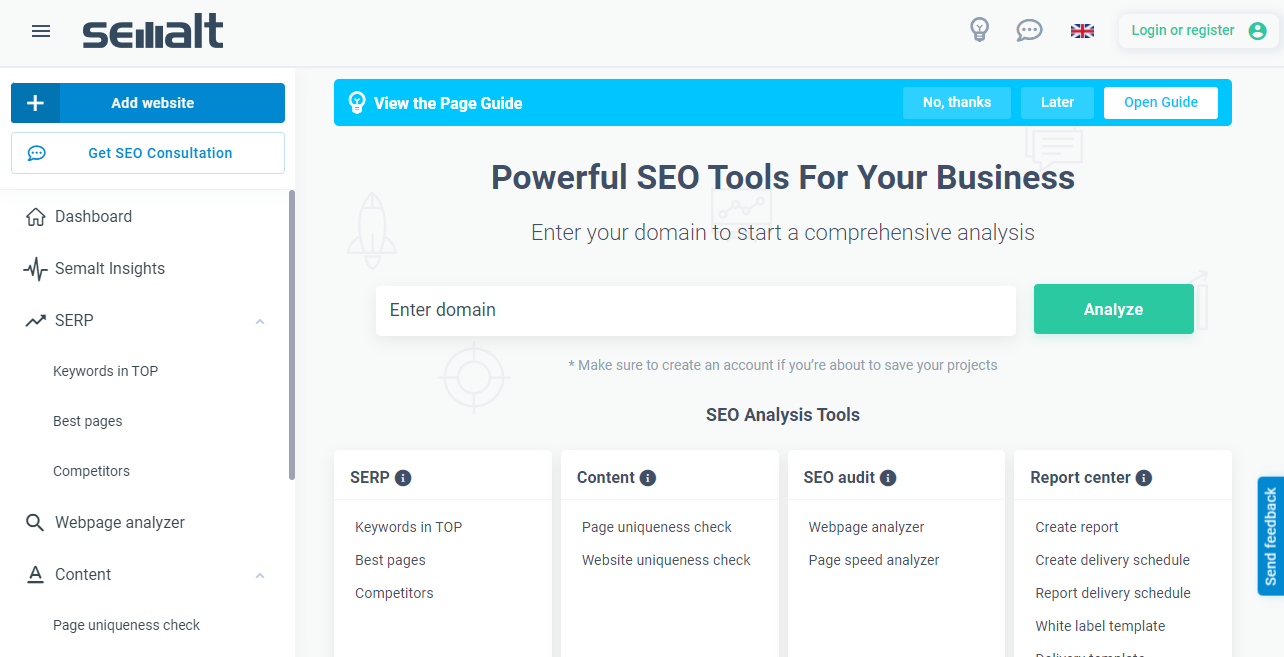Semalt: A Thorough Guide To Search Engine Optimization

If you've ended up on this page, it's probably because you've come across the word SEO before. But maybe you're not quite sure yet what that really means? Or maybe you just want to get smarter in the field?
Either way, you can get help in this article where we will give you an explanation of what SEO really is. We will also give you tips and tricks on how to work with SEO by yourself.
But first, we need to take a look at the term SEO.
What is SEO?
SEO is an abbreviation for Search Engine Optimization, and it actually describes the work very well. Search engine optimization is, as the name implies, the work involved in optimizing a website based on the factors that search engines look at when ranking websites.
Working with SEO is generally about making your page relevant to the user's search and at the same time making your page better than your competitors', so that you get better rankings than them.
Why is it called SEO?
When it comes to SEO, I am tempted to say that this dear child has many names - it is also not uncommon for me to come across the concepts of keyword optimization, search engine optimization, Google optimization or for that matter SEO optimization. Here the latter must almost be said to be the extra optimized of its kind - at least if we are to take the meaning of the word literally.
Finally, we also have a technical term called organic search engine optimization. It is called organic because the results are "natural" as opposed to the paid Google Ads results.
How do I do search engine optimization?
SEO is not something you can just do once, put it on your website and then you are done. You need to think about SEO as a process. SEO consists of several different work areas and subject areas, and that is precisely why for many it can be really complicated.
Let me give you a brief introduction to the three main elements of SEO:
1. The technical part
Most companies do not deal with this part. They have usually bought a website where the technique plays a long way along the way. Web designers and web developers often have a particular focus on the visual and functional aspect when designing a website - and this is not necessarily what works particularly well in search engines. As a result, the technique becomes a problem that needs to be optimized.
2. The content part
This part is for most people somewhat easier to understand: You need to write good content on your website. But it is often easier said than done. This is because it becomes especially tricky when the communication has to be created based on the users' different search types, search phrases and search intentions.
3. The authoritarian part
Google wants to give good recommendations to users. This means that Google favours the pages that have the best content and the highest authority - and you surely want to be Google's favourite because then you end up at the top of the search results. The authority is achieved, among other things, by other websites linking to yours. That work is called link building and can be an extensive process.
When working with SEO, you often start with the technical part. It is the platform and the website that must play. The content part and the authoritative part are often ongoing works where you test, produce and optimize your content and create external authority and credibility.
But Content and Authority as such can also be two sides of the same coin. For example, when you work with topic clusters and content universes, you both build content and create authority within the topics you build content around.
What are the tasks in SEO?

There are a large number of parameters that together make up the work of SEO. The work tasks can, somewhat simplified, be divided as follows:
SEO-analysis
Here you go through the website to find out what to optimize. There are a number of different SEO analytics, e.g. technical analysis, content analysis and EAT analysis.
Link analysis
This can be based on your own website, where you look at the type of links that link to you. It may be that it is harmful links that link to you, and then these need to be cleaned up. Link analysis can also show if these are the right links you have or you need more of them. This is typically done by also doing link analysis on competitors' websites with a tool like Semalt's Dedicated SEO Dashboard.

Keyword analysis
In this process, you will find the keywords that your customers are searching for that can help generate sales - either directly or as part of your online sales funnel.
Web texts and text constitution
You will not be found without your content being about what your potential customers are looking for. Therefore, a large part of the SEO work is to work with copywriting and content production. Some will call it SEO texts, but this concept has unfortunately gained a bad reputation. Many people perceive SEO text as indifferent and pointless text. What you really need is a data-driven copywriter. Data-driven because the copywriter needs data to find keywords and continuously optimize.
SEO-strategy
This is where you link all the analyses together and define the grand plan. You can describe your starting point and your market position in comparison to your competitors. You describe your objectives for your SEO work and you describe where you need to be visible in the search engines. In the strategy, you will typically also describe which SEO tactics you want to use.
Local SEO
This part is especially important for local craftsmen, therapists, restaurants and freelancers, where potential customers usually choose local suppliers. Here you should for example work with profiles in Google My Business and local landing pages. You should also make sure that your address is clearly marked.
Technical SEO
In technical SEO, you work to get domain strategy, HTML, JavaScript frameworks and server technology to play so that the search engines can best index the website. You need to make sure that there is no automated content that creates duplicate content and then you need to be aware of security issues and speed challenges.
On-page SEO
This part is about optimizing the elements on the page that Google attaches high importance to in the rankings. It's about 200 factors, and only Google itself knows all 200. However, due to solid experience, we know that optimizing page titles, meta descriptions and textual content on the site is something that Google highly values. In many cases, it is something that the company itself can stand to do.
Linkbuilding
When you do link building, you try to get other websites to link to your own website. In the eyes of Google, a link acts as a kind of recommendation for your website and your business. So the better (and not necessarily the more) recommendations, the higher Google will rank your website. You can e.g. get links through collaborations with customers, suppliers or sponsorships. You can also use digital PR, where you get reviews on other websites through good stories or interesting content. There are also more shady forms of link building where you use Private Blog Networks (PBNs), but I would strongly warn against that. Link building is a big part of the ongoing work and it can be a tough nut to crack for many companies. Therefore, they often choose to outsource this part to an SEO office.
Impact measurement and reporting
Here you measure the things you optimize. These are your Google placements and your Google traffic. You look at whether the traffic provides sales, inquiries, registrations or anything else you might want with the traffic.
Surveillance
With the right tools, you can monitor your website for ongoing errors. You can e.g. use the Dedicated SEO Dashboard and Google Search Console for this process.
SEO periodic table
What to start with and how much to work on depends on your specific situation. When we work with SEO, we try to find the area where we can create the biggest change first. This is what we call the biggest gain first.
Under each area and task, there are many more things you need to be aware of. We've just listed some of them here. Of course, there is much more to working with SEO than I can get through in one article, but I still hope that I have given you a good insight into what working with SEO will mean and how you can grasp it yourself.